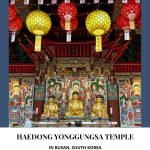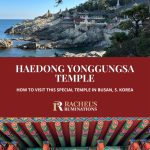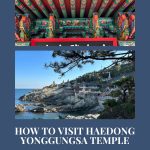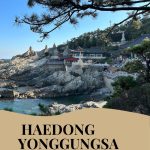How to visit Haedong Yonggungsa Temple (Busan)
The following is a guest post by Ben Lloyd.
Busan, South Korea, is home to the wonderfully colourful Haedong Yonggungsa Temple. Beautifully crafted and extravagant, a visit to this most beautiful temple is an absolute must when you find yourself in Korea’s second largest city.
Disclosure: This article contains affiliate links. If you click on one and spend money, I (Rachel) will receive a small commission. This will not affect your cost.
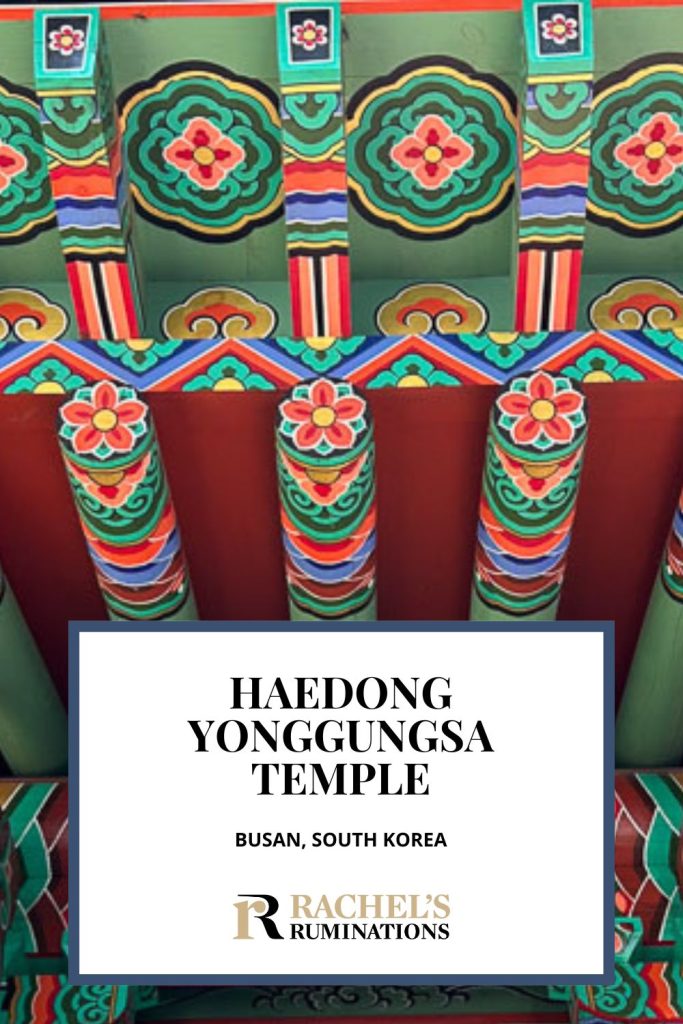
History and significance of Haedong Yonggungsa Temple
Haedong Yonggungsa Temple (also sometimes spelled as Haedong Yonggung Temple) was originally built in 1376 by the Buddhist teacher and monk, Naong, during the Goryeo Dynasty. Its name at that time was Bomun Temple. Unfortunately, a fire destroyed the original temple during the Japanese invasions in the late 1500s. It remained derelict and abandoned for nearly 400 years.
Mercifully, restoration works began on the temple in the 1930s. In 1974, it was renamed as Haedong Yonggungsa Temple, the name it keeps to this day.
Haedong Yonggungsa Temple is a significant temple in South Korea as it is one of the very few examples of a Buddhist temple located by the sea. More often than not, Buddhist temples within the Korean peninsula are situated high in the mountains.
The temple honours the Sea Goddess of Mercy, hence the idyllic location in which it was built. There are 108 steps down to the temple from the main entrance, each bringing you a step closer to the sea.
Haedong Yonggungsa Temple is certainly one of the most unique places of worship in the whole of South Korea.
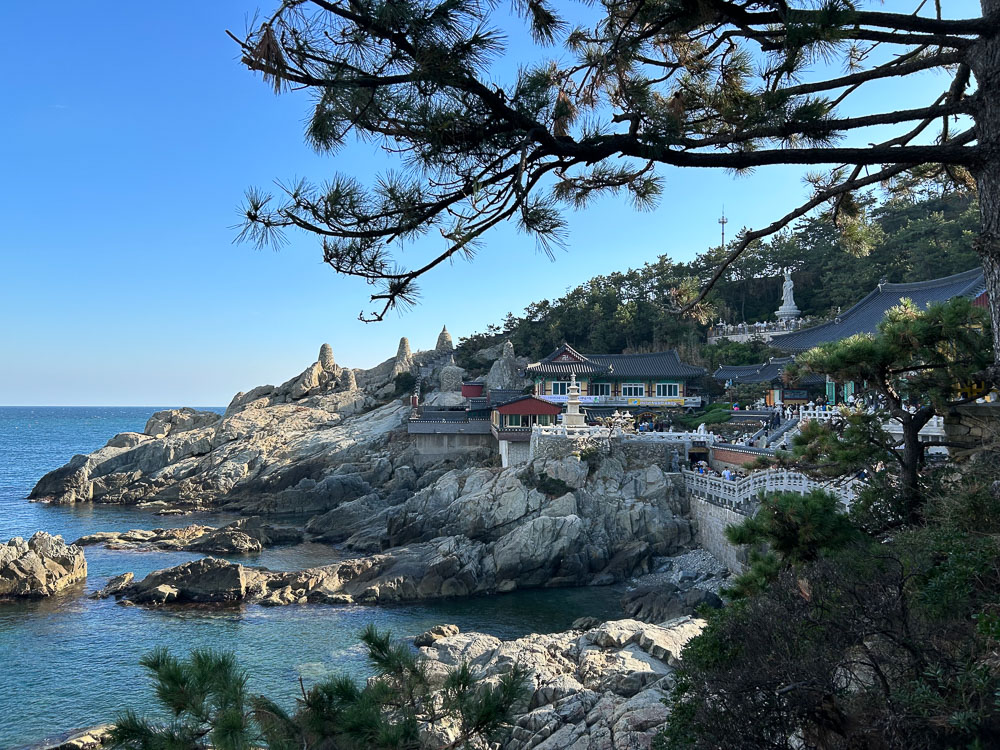
Best things to see in Haedong Yonggungsa Temple
Naturally, the beauty of the temple buildings makes them the highlight of any trip to Haedong Yonggungsa Temple, but there are plenty more intricacies and details to explore when you visit the temple. Here is a quick overview of just some of the other highlights:
Sunrise at Haedong Yonggungsa Temple
Easily one of the most beautiful sights you can witness in Busan, watching the sunrise at Haedong Yonggungsa Temple is something that should be on every Korean bucket list. The temple typically opens just before sunrise and visitors can start to wander through the gates at around 5am, eagerly jostling for the best spot to watch the dazzling, natural show.
12 zodiac figures
The first thing that greets you on your way into the temple grounds (other than the droves of tourists), are the 12 stone zodiac statues in the form of animals that line the path by the entrance of the temple. You’ll find visitors to Haedong Yonggungsa Temple crowding around the figures, placing coins on them for good luck and posing for photos. The Zodiac animals are, of course, a set of 12 calendar symbols. Each animal represents a year in the 12-year cycle based on Jupiter’s orbit. It is tradition to place money next to the zodiac animal that represents your year of birth, in order to gain protection from the corresponding zodiac protector.
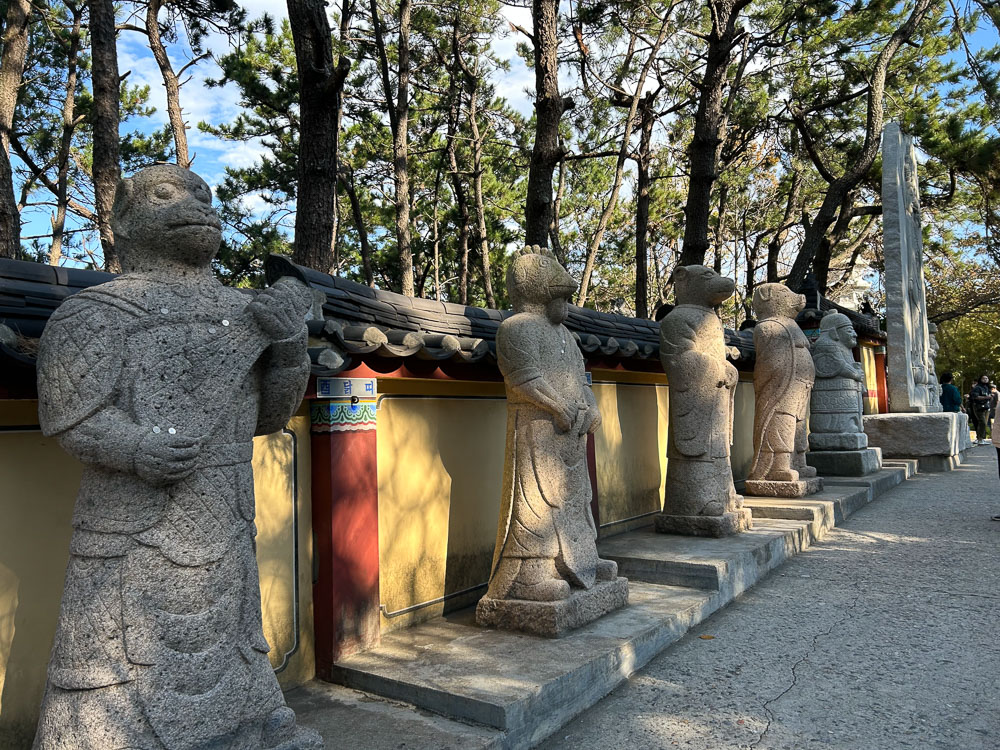
Buddhist Goddess of Mercy
Arguably the focal point of the entire complex is the gigantic Buddhist Goddess of Mercy statue (Haesu Gwaneum Daebul), also called the Seawater Great Goddess Buddha. It sits in the forest, directly above Haedong Yonggungsa Temple. In fact, the entire temple honours the Sea Goddess, as she is more commonly known. This is one of only three temples in South Korea dedicated to this sea goddess.
For 5000 won (about $4.00), you can purchase mini figurines of the Sea Goddess of Mercy. Leave them by the statue as a gesture of goodwill.
If you’re going to be visiting Seoul as well, you might enjoy these articles:
The temple areas
The structures on the site are the main temple sanctuary, Daeungjeon; Yongwangdang shrine; Gulbeop Buddhist sanctum, which is inside of a cave; and a three-story pagoda as well. The pagoda bears four lions symbolizing joy, anger, sadness and happiness. Walk down 108 steps to get closer to the water, enjoy the sea breeze, and get pretty views of the temple complex. Stone lanterns line the paths through the temple complex. From the golden statue of the Bodhisattva, perched on a rock, you’ll enjoy a beautiful view out over the water and coastline.
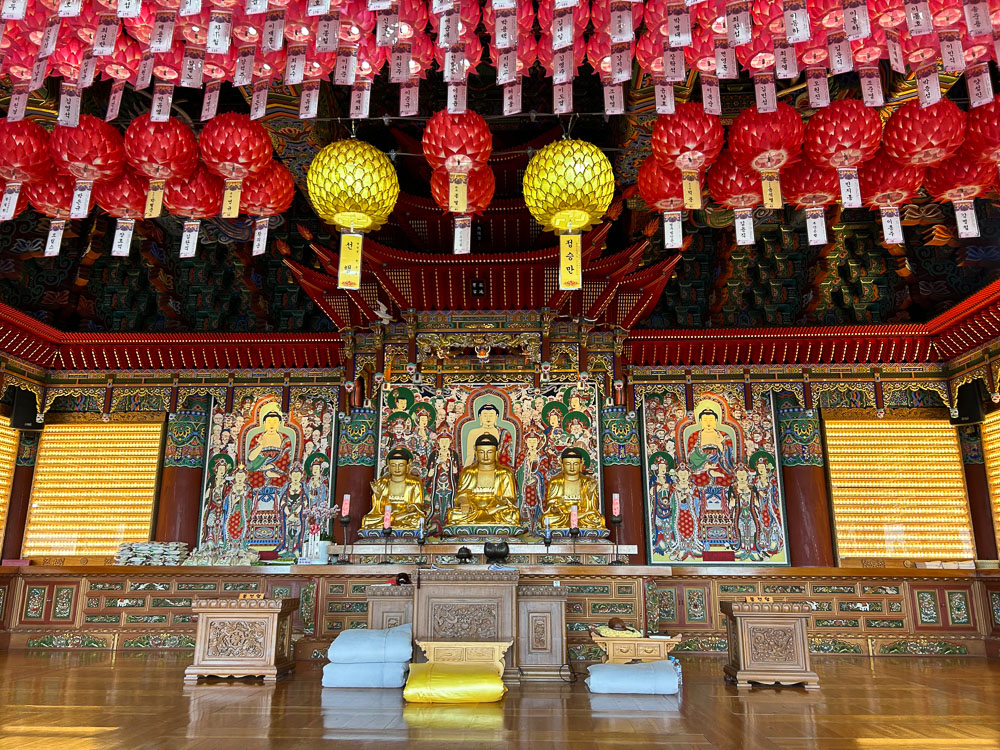
What is the best time to visit the temple?
Visiting Haedong Yonggungsa Temple is a rewarding experience, irrespective of the time of year you choose to visit. Having said that, however, there are a few times throughout the year that offer a unique and distinctive experience that you may want to try and see in person.
- The best time of year to see cherry blossoms in full bloom in Haedong Yonggungsa is late March – early April. It really is a spectacular sight to behold!
- Equally, if you dream of seeing the temple draped in a layer of snow, then you should aim to visit Haedong Yonggungsa Temple in January or February. The early months of the year offer the best chance of heavy snowfall all over South Korea.
- Another popular time of year to visit Haedong Yonggungsa Temple is during Buddha’s birthday, when Korean temples are decorated with hundreds of paper lanterns. The exact date varies each year, depending on the Asian Lunisolar calendar, but it typically falls in April or May.
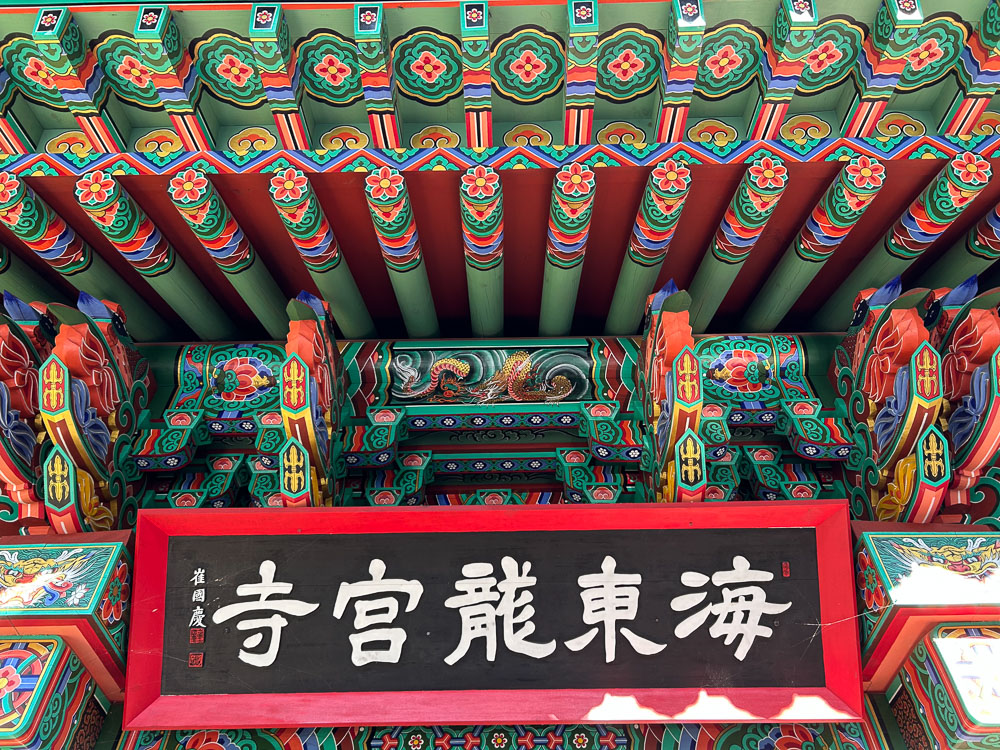
Tips for visiting the temple
- Get there early. Visiting the temple is one of the most popular things to do in Busan and that is evident by the number of tourists that flock to the site. Get there in the early morning, preferably on a weekday, not only to avoid the crowds, but also to experience the beautiful sunrise.
- Another note on crowds: As mentioned above, the temple will be especially crowded at popular times of year: at the Buddha’s birthday (in April or May), when the cherry blossoms are in bloom, and at New Year or other holidays. Depending on your preference, this may be something you want to avoid, or it might be the best time for you, allowing you to observe local traditions.
- Read about the history of the temple online as you are walking around. In order to fully appreciate the significance of the temple, you should try and engage in some light reading as you walk around. Often the signage in the complex is very brief. Think about buying a SIM card in Busan Gimhae Airport on arrival. It’s the easiest way to make sure you have internet as you travel around Haedong Yonggungsa Temple.
- Food and drink is overpriced at the entrance. This one is pretty self-explanatory but with it being a tourist hot-spot, local businesses are trying to cash in. If you can, opt to wait until you get back into Busan before purchasing food and drink. Or bring snacks and water along with you.
Book accommodations near the temple. Use the map function to see what’s nearest so it’s easier to get there for sunrise.
How do you get to Haedong Yonggungsa Temple?
Haedong Yonggungsa Temple is in Gijang-gun, directly on the northeastern coast of the city of Busan. It is roughly 6km (4 mi) north of Haeundae, a beautiful beach and one of the city’s most popular places to visit.
There are a few different options – by private and public transport – for getting to Haedong Yonggungsa Temple from the central areas in Busan. Here is a quick rundown of the easiest suggestions:
- Busan City Tour Bus: From Busan central bus station, take the Red Line for 7 stops towards Haeundae Beach. Then transfer onto the Blue Line to reach the Haedong Yonggungsa Temple stop.
- Public Bus: Take bus 181 departing from the Haeundae station (exit 7). It takes roughly 45 minutes to get to the Haedong Yonggungsa stop (directly outside Skyline Luge Busan). From the bus stop, it’s a simple 5-minute walk to the temple entrance.
- Car: If you have hired a car in Busan, it should take around 20 minutes to drive north from Haeundae Beach. There is a paid parking lot at the site.
- Taxi: Arguably the easiest and most straightforward route to reach Haedong Yonggungsa Temple is to jump in a taxi. Taking 20-25 minutes from Haeundae Beach, it will typically cost somewhere in the region of 8000-10000 KW (about $6.50-8.00).
When does the Haedong Yonggungsa Temple open?
The opening times for Haedong Yonggungsa Temple vary throughout the year and are typically based around the relative times of sunrise and sunset. In general though, the Haedong Yonggungsa Temple opens at 5am and closes at sunset.
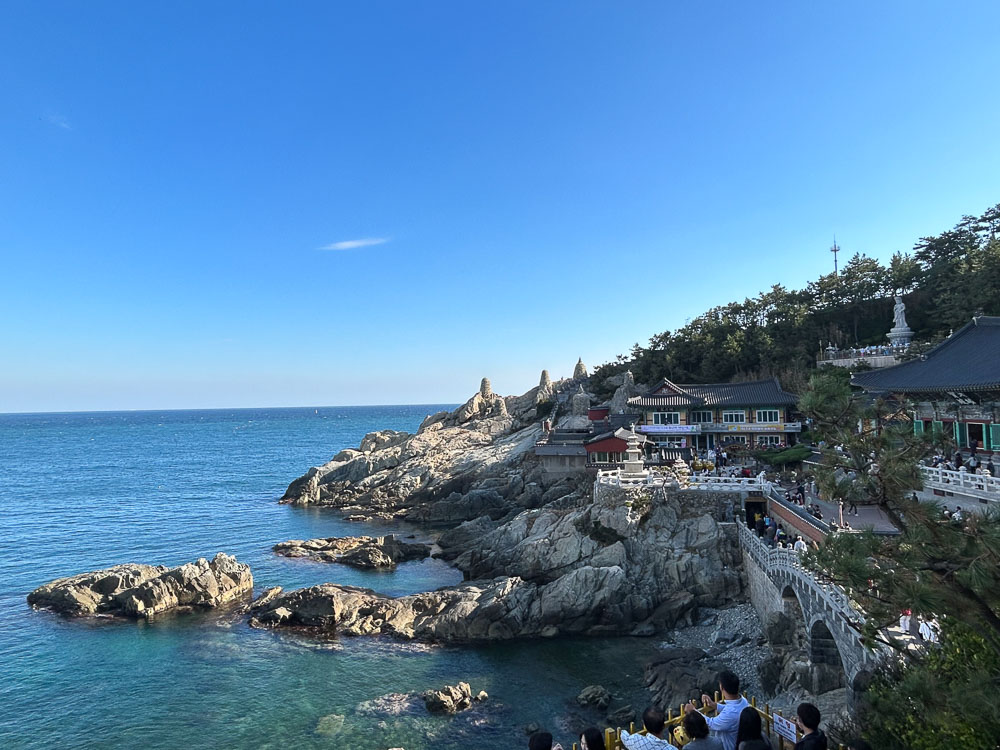
How much does it cost to visit Haedong Yonggungsa Temple?
Visiting Haedong Yonggungsa Temple is completely free, making it one of the cheapest and best things to do in Busan. Naturally if you visit in a car you still have to pay for parking and obviously the food and drinks are going to be an expense. Overall, though, it makes for a very cheap day out in South Korea’s second largest city.
Can you do a guided tour of Haedong Yonggungsa Temple?
Despite Haedong Yonggungsa being a relatively small complex, it has a rich and fascinating history that is best understood when a knowledgeable guide is highlighting the significant areas of the temple. While it isn’t currently possible to do a guided tour of only Haedong Yonggungsa Temple, it is possible to participate in a broader full-day Busan city tour, which includes a guided tour of the temple by the sea.
How long do you need to spend at Haedong Yonggungsa Temple?
It is recommended that you spend around 1-1.5 hours at Haedong Yonggungsa Temple. It’s a lovely sight to see and definitely worth visiting when you’re in Busan, but it’s a relatively small complex and doesn’t take too long to wander around. Planning to spend 2 hours is more than enough. That will give you time to have a hot drink at one of the cafes near the entrance.
There we have it folks: a conclusive round-up of everything you need to know about visiting Haedong Yonggungsa Temple. The temple is famous within Korea for being one of the only Buddhist temples that isn’t nestled in the mountains, which only adds to the appeal of visiting this wonderful seaside attraction.
My travel recommendations
Planning travel
- Skyscanner is where I always start my flight searches.
- Booking.com is the company I use most for finding accommodations. If you prefer, Expedia offers more or less the same.
- Discover Cars offers an easy way to compare prices from all of the major car-rental companies in one place.
- Use Viator or GetYourGuide to find walking tours, day tours, airport pickups, city cards, tickets and whatever else you need at your destination.
- Bookmundi is great when you’re looking for a longer tour of a few days to a few weeks, private or with a group, pretty much anywhere in the world. Lots of different tour companies list their tours here, so you can comparison shop.
- GetTransfer is the place to book your airport-to-hotel transfers (and vice-versa). It’s so reassuring to have this all set up and paid for ahead of time, rather than having to make decisions after a long, tiring flight!
- Buy a GoCity Pass when you’re planning to do a lot of sightseeing on a city trip. It can save you a lot on admissions to museums and other attractions in big cities like New York and Amsterdam.
Other travel-related items
- It’s really awkward to have to rely on WIFI when you travel overseas. I’ve tried several e-sim cards, and GigSky’s e-sim was the one that was easiest to activate and use. You buy it through their app and activate it when you need it. Use the code RACHEL10 to get a 10% discount!
- Another option I just recently tried for the first time is a portable wifi modem by WifiCandy. It supports up to 8 devices and you just carry it along in your pocket or bag! If you’re traveling with a family or group, it might end up cheaper to use than an e-sim. Use the code RACHELSRUMINATIONS for a 10% discount.
- I’m a fan of SCOTTeVEST’s jackets and vests because when I wear one, I don’t have to carry a handbag. I feel like all my stuff is safer when I travel because it’s in inside pockets close to my body.
- I use ExpressVPN on my phone and laptop when I travel. It keeps me safe from hackers when I use public or hotel wifi.


